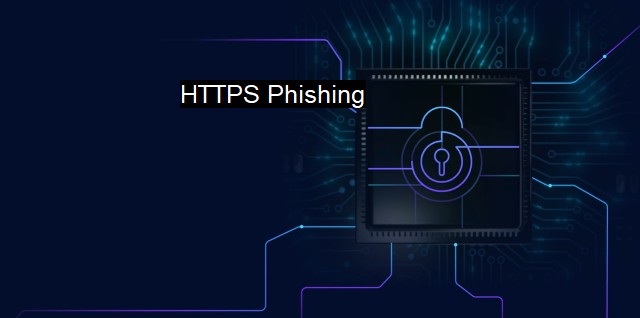What is HTTPS Phishing?
How to Protect Yourself from HTTPS Phishing: A Modern Type of Cyber-Attack Explained
HTTPS phishing is a cyber threat that has gained significant attention among internet users and cybersecurity experts across the globe, thanks to its sophisticated nature of operation. As its name implies, HTTPS Phishing is a type of phishing attack that occurs on a Secure Sockets Layer (SSL) certificate-equipped site. Hence, its complexity and sophistication are markedly higher than other types of cyber threats, leading to severe consequences for online users.Traditionally, phishing attacks have been effective because malicious individuals convince their victims to share sensitive and valuable information impersonally, making it difficult for cybersecurity tools to trace. phishing is an art of deceit - it employs various tactics such as imitating the email address of a credible organization or creating an almost identical website clone to dupe unsuspecting users. A hacker tricks an individual into revealing sensitive user details, such as login credentials, credit card number, or social security number, which they exploit for nefarious intents.
HTTPS Phishing adds a new twist to this threat by adding an SSL certificate to their illegitimate website. SSL certificates that use HTTPS protocols work by encrypting the information transferred between the user's web browser and the target website. This is particularly useful against traditional kinds of cyber threats, such as network intercept hackers known as man-in-the-middle attacks. Owing to the presence of SSL certificates, users are confident that they are securely interacting with the right website.
Unfortunately, cybercriminals have adopted this technology to increase their success rate. Apparently, many internet users have been trained to look out for the 'lock' icon on their browsers, representing the presence of the SSL certificate. So by integrating SSL certificates in their phishing websites, cyber attackers are more likely to succeed in their illegitimate ventures.
To perform HTTPS phishing, an attacker needs to acquire an SSL certificate for their bogus website, which would sport the typical HTTPS and lock symbol, indicating a secure site. By doing this, they dupe unwary users into trusting the site, leading them into releasing their credit card details, social security number, or other vital data.
The reality concerning HTTPS Phishing emphasizes the importance of enhanced cyber hygiene habits. Though SSL certificates and the HTTPS protocol can provide a first line of defense, they cannot single-handedly guarantee security against phishing attacks. SSL encrypts data transfer, making sure the information you enter on the site is only accessible by the website's servers. if the website belongs to a cybercriminal, your data will only be protected during its transfer but then end up in the hands of attackers.
Using robust cybersecurity and antivirus software is crucial to ward off phishing threats. Good cybersecurity and antivirus programs warn the users if a site is potentially harmful and block access to it automatically. Some even provide real-time protection against malicious sites by triggering alerts if the site isn't on a secure connection.
To arm oneself against HTTPS phishing, it is crucial to review the website's URL carefully. Often, phishers create domains that closely resemble the original but with slight misspellt words or interchanged characters. Recognizing such inconsistencies can be the difference in preventing a phishing attack.
While SSL certificates on fraudulent websites can easily trick individuals into trusting a phishing website, it's becoming more critical than ever to question and verify the credibility of websites. Be it by checking their contact information, reading reviews, or cross-referencing information from other trusted sites.
While HTTPS Phishing uses a mix of technical trickery and human negligence, users can counter with vigilance, awareness, and a solid cybersecurity background. Solid understanding of the threat, rigorous verification process accompanied by a high-performance antivirus system, can significantly constrain the increasing wave of HTTPS phishing.

HTTPS Phishing FAQs
What is HTTPS phishing?
HTTPS phishing is a type of cyber attack where attackers attempt to steal sensitive information of users by creating fake websites that appear legitimate. In this type of phishing attack, attackers use HTTPS encryption to make the fake website appear secure and trustworthy.How can I protect myself from HTTPS phishing?
To protect yourself from HTTPS phishing, always check the URL of the website you are visiting. Make sure that the URL starts with "https" and that there is a padlock icon displayed in the address bar. You should also ensure that your antivirus software is up-to-date and use a reliable browser that has built-in phishing protection.Can HTTPS phishing be detected by antivirus software?
Yes, most antivirus software can detect HTTPS phishing attacks. Many antivirus software use machine learning algorithms to identify phishing websites, and some also have browser extensions that can detect and block phishing attacks in real-time.What should I do if I fall victim to an HTTPS phishing attack?
If you fall victim to an HTTPS phishing attack, you should immediately change your passwords for all affected accounts and monitor your accounts for any suspicious activities. You should also report the incident to the relevant authorities, such as your bank or credit card company, and consider freezing your credit to prevent any further unauthorized activities.| | A | | | B | | | C | | | D | | | E | | | F | | | G | | | H | | | I | | | J | | | K | | | L | | | M | |
| | N | | | O | | | P | | | Q | | | R | | | S | | | T | | | U | | | V | | | W | | | X | | | Y | | | Z | |
| | 1 | | | 2 | | | 3 | | | 4 | | | 7 | | | 8 | | |||||||